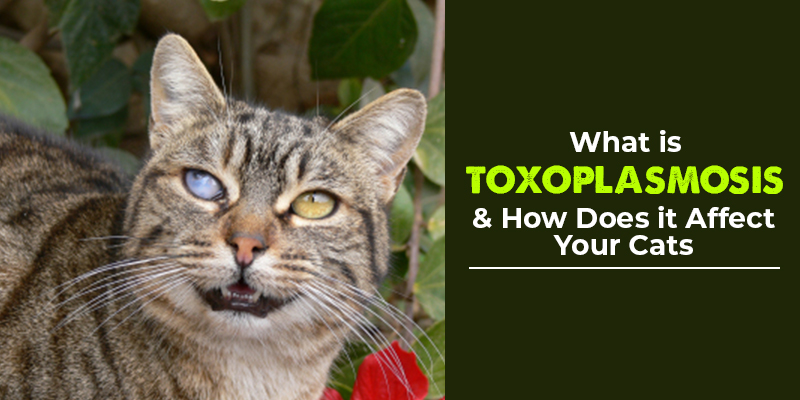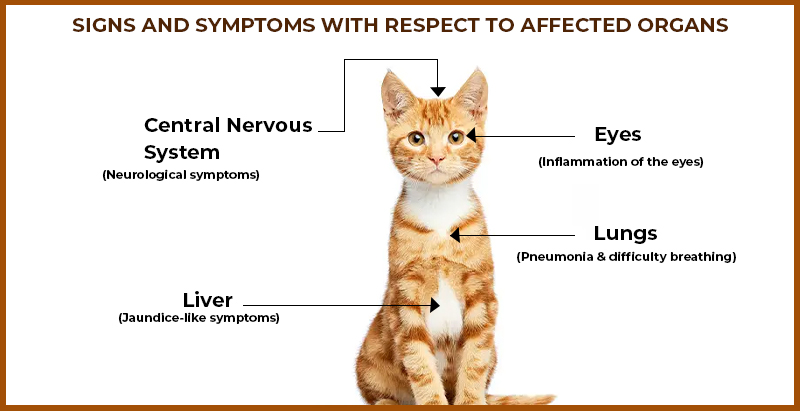
Cats are susceptible to various infections and diseases. This is especially true if your cat frequently goes on good hunting expeditions or interacts with neighborhood stray cats. Though cats develop no signs or symptoms for most of the ailments, they may get serious when the infection progresses and becomes severe.
Toxoplasmosis is one of the most common diseases that occurs in cats. This blog will share everything you should know about Toxoplasmosis, such as what is Toxoplasmosis, how does Toxoplasmosis affect cats, and how Toxoplasmosis is diagnosed and treated in cats. We will also share some prevention measures to safeguard your pet from this infection. Keep reading to know why you should learn about Toxoplasmosis in cats.
What is Toxoplasmosis?
Toxoplasmosis is a parasitic disease caused by the protozoan parasite Toxoplasma gondii (T. gondii). It is a single cell parasite that infects nearly all warm-blooded animals, including pets and humans. In animals, wild and domestic felines are the only definitive hosts of the Toxoplasma parasite. It’s a communicable disease, and infected cats transmit the disease to other animals and even humans.

What are the Causes of Toxoplasmosis?
Toxoplasmosis is a disease caused by the protozoan T. gondii. In the environment, toxoplasma exists as infective oocytes (like eggs). These oocytes can live for months in the environment, and sometimes even years.
Some common places where Toxoplasma oocytes may exist include:
- Water
- Soil
- Food items
- Raw meat
- Fruits and vegetables
- Litter boxes
- Gardens
- Lawn
- Places where cats poop
Toxoplasmosis in Cats
Cats are the only definitive hosts for T. gondii protozoans, meaning that toxoplasma can sexually reproduce only in cats. When cats ingest oocytes from any of the sources mentioned above, the immature oocytes mature inside the cat’s intestines, reproduce to make oocytes, and are shed in cat feces. The shed oocytes are zoonotic and infect other warm-blooded animals and humans.
Life Cycle of Toxoplasma Protozoan
The life cycle of T. gondii is complex and mainly involves two types of hosts: definitive hosts and intermediate hosts. Definitive hosts are the hosts in which a parasite reproduces (sexual reproduction) and forms oocytes (eggs). For T. gondii, felines are the only definitive hosts.
Intermediate hosts are the hosts in which a parasite clones itself (asexual reproduction) and multiplies. Here, the parasite developes in to tachyzoites and bradyzoites, which are responsible for causing the infection and develop sysmptoms. All non-feline animals are intermediate hosts for T. gondii.

When cats ingest toxoplasma protozoan (whether oocytes, tachyzoites, or bradyzoites), it either matures in to tachyzoites causing infection symptoms or reproduces to form oocytes. This oocytes are further shed into cats feces which become infective in 1-5 days.
Signs and Symptoms of Toxoplasmosis in Cats
The signs and symptoms of Toxoplasmosis are mild in most cats and thus often go unnoticed in healthy ones. However, in immunocompromised cats, or cats with feline leukemia or feline immunodeficiency virus, clinical signs such as fever, loss of appetite, and lethargy are common.
Moreover, the clinical signs may also vary depending on the site of infection. Following are the complications associated with a specific site of infection.

Lungs: When the toxoplasma infection spreads across the lungs of a cat, it results in pneumonia and difficulty breathing.
Liver: Toxoplasmosis, when it affects the liver in cats, results in jaundice-like symptoms. The cat’s skin and mucous membranes turn yellowish in such cases.
Eyes: When Toxoplasmosis infection affects the eyes, it causes inflammation of the eyes. This may also lead to abnormal pupil size, eventually resulting in blindness.
Central Nervous System: Toxoplasmosis infection, when spread across the CNS, results in the most severe symptoms. These symptoms include increased sensitivity to touch, lack of coordination, head pressing, twitching ears, circling, personality changes, trouble chewing and swallowing, seizures, and urinary incontinence.
These severe symptoms are rare, and most of the cats are asymptomatic of toxoplasma infection.
Diagnosis of Toxoplasmosis in Cats
As most cats show no signs or symptoms of the Toxoplasmosis infection, the diagnosis becomes challenging. However, when suspected, veterinarians usually advise doing the following confirmatory tests:
- Blood serum tests to check IgM and IgG antibody levels.
- Clinical and laboratory tests
- Cytological test
- Fecal examination to check for the presence of oocytes
Treatment of Toxoplasmosis in Cats
Usually, treatment is not needed for toxoplasmic infections in cats. However, symptomatic cats can be treated with proper care and medications. Usually, antibiotics and anti-protozoals are used to treat the infection. If there’s any inflammation in the cat’s body, corticosteroids are used. The treatment is continued until the signs and symptoms of toxoplasmic infections are gone.
In cats with CNS infections, the treatment may take some time to respond. The inflammation around the eyes is treated symptomatically. The treatment must be started immediately once severe symptoms of toxoplasmic infections are observed in cats to prevent any potential hazards.
How to Prevent Toxoplasmosis in Cats
Though Toxoplasmosis is a mild infection in cats and rarely a serious ailment, it’s crucial to safeguard cats from the infection. Following are a few tips and tricks to prevent Toxoplasmosis in cats:
- Keep your cats indoors and avoid their interaction with stray cats.
- Don’t let your pet go hunt birds or rodents.
- Feed your cat cooked meat or special canned food. Avoid feeding raw meat to cats.
- Empty cat’s sandbox or litter box daily.
- Wear gloves when cleaning and wash your hands afterwards.
Read More : Worms in Cats & How to Treat Them
Toxoplasmosis, Cats, and Humans: Does Toxoplasmosis Affect Humans?
Humans can get infected with T. gondii. However, the primary source of infection in humans is uncooked meat and contaminated soil, rather than an infected cat. Moreover, Toxoplasmosis seldom causes any significant health issues in humans. Only people with compromised immune systems are at risk.
Wrapping Up: Should You Care About Toxoplasmosis in Your Cat?
Toxoplasmosis is not a serious health hazard for cats. Most cats with T. gondii infections rarely show any symptoms. However, it still should not be neglected. Ensuring the well-being of your pets is an undeniable advantage. By taking precautions and following hygiene practices, you can ensure good health for your furry friend and your family.






